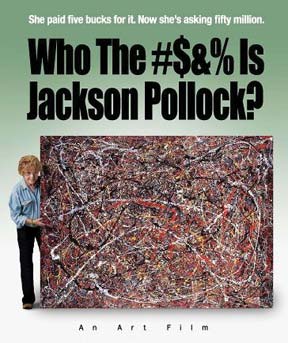|
Vol. 2, Issue #8 May 11th - May 24th, 2007
Film Review: Who the #$&% Is Jackson Pollock? (Picturehouse)
Teri’s son contacted a forensics expert, Peter Paul Biro, who uses CSI-styled testing to authenticate works of art. Biro found a fingerprint on the back of the painting and was able to prove that it matched a fingerprint found on a paint can that is on display in Pollock’s historic studio, yet no matter how much evidence piled up – even enough to convict a man of murder – the established art experts refuse to have anything to do with Horton or her painting. The reason given is the lack of provenance, however other original Pollocks have been found in dumps– the artist thought nothing of throwing out paintings he didn’t like. The film shows the old school New York art establishment, the ones who have been eclipsed by the “Juxtapoz” crowd over the last decade, as a citadel that is obsessed in keeping it’s interest in the upper class. The forensics evidence pushes them into a corner, where the “expertise” of these curators and dealers was defeated by scientific method, and they conspire to shoot down this new form of authentication. But the film also shows that Horton is equally insane in her Philistine interest; she turned down an $8 million dollar offer for the painting out of principal –and because someone told her it could be worth $25 million. By the end it becomes obvious that the actual image is absolutely immaterial to anyone involved. This wild goose chase has nothing to do with art; it’s all a money game to attach a famous name to the painting so that it has monetary value. The film raises questions of class, art vs. science, and the validity of the American art market in general. In the end the film refuses to answer any of the questions, but simply shows that sad state of today’s art establishment. |
||
©2007 NONCO Media, L.L.C.

 Harry Moses directed over 100 stories for “Sixty Minutes” and this documentary is told in the very same flat style. The film follows the plight of Teri Horton, a retired truck driver who went to a thrift shop fifteen years ago and found an unsigned painting she thought was so ugly that she bought it for $5 to take to her friend’s trailer so they could throw darts at it. Fortunately, it was too big to get through the trailer door, so she eventually tried to unload it in a garage sale where a local art teacher saw it and thought it could be an original painting by the father of the abstract expressionist movement, the late Jackson Pollock. The title comes from Teri’s reaction to the news. Every dealer Teri contacted either dismissed the idea of it being a Pollack out of hand, or simply never called her back.
Harry Moses directed over 100 stories for “Sixty Minutes” and this documentary is told in the very same flat style. The film follows the plight of Teri Horton, a retired truck driver who went to a thrift shop fifteen years ago and found an unsigned painting she thought was so ugly that she bought it for $5 to take to her friend’s trailer so they could throw darts at it. Fortunately, it was too big to get through the trailer door, so she eventually tried to unload it in a garage sale where a local art teacher saw it and thought it could be an original painting by the father of the abstract expressionist movement, the late Jackson Pollock. The title comes from Teri’s reaction to the news. Every dealer Teri contacted either dismissed the idea of it being a Pollack out of hand, or simply never called her back.